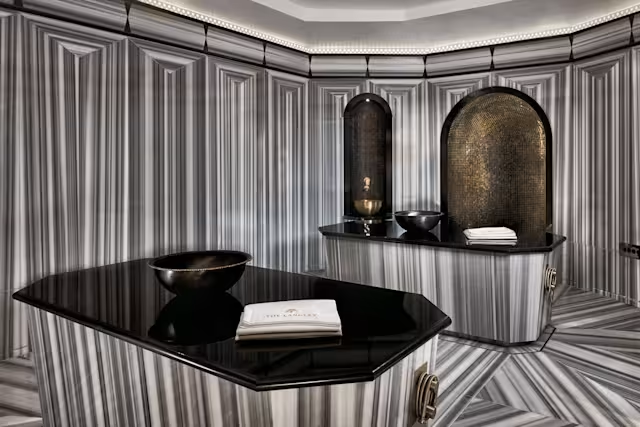Why Try A Spa Sauna?
Part of the Spabreaks.com Spa Treatment Guides
Saunas are a wellbeing practice that have been used for many years in different cultures around the world. They are typically associated with Finnish and Estonian cultures, but are now fairly commonplace in gyms, spas and leisure facilities. You can even have them in the home. They can be used independently or as part of a wider thermal experience, and are particularly soothing after a workout or on cold winter days. Just make sure you drink enough water!
What is a sauna?
A sauna is usually a self-administered experience that sees you sit in a cabin containing heat (usually dry) of temperatures between 70° to 100° Celsius. The purpose is to warm up muscles and induce sweat to help relax and detox the body, release tension in the muscles and support a variety of other wellbeing benefits as well.
Lots of us experience them at a gym or spa, where you spend time in the heat after working our or after a swim. On a spa break they often feature as part of a wider thermal suit experience, which can include other facilities of varying temperatures, such as a caldarium, sanarium, different types of steam room, ice caves, plunge pools and more. Each part of the experience provides different health benefits as does the journey as a whole.

Types of sauna
There are four basic types of sauna, drawing their heat from wood, electricity, gas or sometimes solar power. The four types are:
- Finnish sauna: where wood is burned to generate heat. Some have a chimney, and some don’t (smoke sauna), and the latter is the most traditional.
- Dry sauna: Where the emphasis is on low humidity, usually around 20% or less.
- Steam bath (Turkish bath): Also known as a steam room, a steam bath is where the emphasis is on wet heat and humidity.
- Infrared saunas: These use light to create heat.
There are also features that make up part of a wider thermal experience. These are not saunas, but are additional heat and ice facilities:
- Foot spas: Like Jacuzzis for your feet!
- Caldarium: A warm air room with an even heat radiating from the walls, floors and seats.
- Sanarium: A cleansing alternative to a traditional sauna with a temperature around 60°C.
- Experience showers: Used to rapidly heat or cool the body and stimulate the circulatory system.
- Tepidarium: Where heated, tiled loungers are designed to heat the body slowly before you move onto the hotter experiences.
- Aromatherapy crystal steam room: Infused with essential oils, often menthol, to aid respiration. Often these rooms are dark and the atmosphere enhanced by details such as lights set out like the stars.
- Salt steam room: A wet heat experience with salt added into the steam.
- Ice fountain/snow cave: Cold rooms or where you scrub ice over your skin from a ‘fountain’.
- Hydrotherapy pool: Often the central feature of a thermal suite/heat and ice experience, hydrotherapy pools are generally set at around 36 degrees to warm up the muscles and relax the body and mind.

What are the benefits of a sauna?
The different types of sauna largely provide the same benefits. They are designed to make you sweat, eliminating toxins, clearing the skin and cleansing the pores. As a result, they are believed to help reduce incidence of the common cold as well as temporarily relieve symptoms as well as reduce stress.
Other benefits include:
- Providing gentle cardiovascular exercise by raising the heart rate with the heat
- Helping to clean and rejuvenate the skin
- Helping to eliminate dead skin cells
- Boosting the immune system
- Soothing muscles
- Hoping to relieve insomnia
- Improving blood circulation
- Supporting respiratory health (especially steam baths)
- May aid weight loss
- Detox
- Can support relief from muscle or joint pain
On another level, the use of the sauna combined with other thermal suite facilities before a spa treatment has been a longstanding recommendation of therapists in order to warm the muscles and prepare the skin for all the beautiful products to come, improving absorption and ultimately helping you to relax so that you get the most out of your treatment.

Thermal suite benefits include:
Thermal suites enhance these wellbeing properties further, by raising and lowering the body temperature in a particular order. Benefits range from general wellbeing to relieving aches and pains, tension relief, soothing the skin, aiding respiration and sometimes helping with rheumatism and conditions like psoriasis. Individual features and their respective benefits may include:
- Foot spas: Help circulation and work on pressure points in the feet.
- Caldarium: Provides an even heat that stimulates circulation and regenerates the body’s natural energy. This effect has often been regarded as having healing benefits causing tense muscles to relax, making the skin smoother, and easing joint pain.
- Salt steam and crystal steam baths: Beneficial for the respiratory system and for rheumatic complaints. The salt steam has the added benefit of a salt water atmosphere, which is great for cleansing and toning the skin and stimulating the circulation.
- Sanarium: The unique blend of heat followed by a stimulating shower boosts the body’s natural defences and promotes circulation, shifting your metabolism up a gear. A Sanarium bath also cleanses the skin and tones the body tissue.
- Ice cave/fountain: Grab a few ladlefuls of ice and rub it over the skin to provide instant cooling. Mix in a cold shower in the ice cave and you will have truly cooled down, contracting your blood vessels, stimulating your circulation and oxygen intake at the same time.
Unique sauna treatments
Some spas go a step further and customise sauna experiences to turn them into unique treatments in their own right.
For example:
- Salt sauna: When the air is infused with specific salts, they can affect cell activity, energy and blood sugar levels, a natural disinfectant and antibacterial and as a result salt saunas are said to be able to help reduce headaches and aid better sleep patterns. Inhaling the particles may also reduce inflammation and mucus in the lungs, improving respiratory conditions such as asthma, allergies, and bronchitis as well as sinus congestion, allowing relief to breathe easier. Skin conditions can also be soothed by the salt sauna, such as eczema and acne.
- Celtic Sauna Ritual: At Galgorm Resort and Spa this ritual infuses the air with essential oils into the air, each with their own beneficial properties. These are examples of spas adding their own spin to a traditional sauna experience.

What is included during a sauna?
How you use a sauna or wider thermal suite is entirely up to you. It’s a self controlled and self administered process, which is one of the things lots of people like about it. It’s also a shared experience in that you don’t tend to have it on your own (unless it’s a private facility).
If you’re using the sauna on its own, then you usually shower beforehand, then enter the sauna, place down a towel on the bench and sit (or lay down) and enjoy the heat. There will often be signage recommending a maximum amount of time to spend in the heat (usually no more than 15 to 20 minutes), however if you start to feel unwell then you should leave immediately. You can take a bottle of water in with you, or make sure you get a glass of water when you come out. You may want to shower afterwards as well, especially if you plan to use the pool or other facilities.
Using a sauna as part of a wider thermal suite
If you are using the sauna as part of a wider thermal suite, and depending on the facilities that the thermal suite has, this is a recommended journey:
- Firstly, it’s recommended that you use the facilities before having a spa treatment, so you can best prepare the skin and body to enjoy your therapy. Then leave products on your skin afterwards to work their magic.
- Then, start with a shower to remove all make-up, deodorants and perfume, and a warm foot bath to relax.
- Head to the lower temperatures of the caldarium for the recommended time.
- The sauna or sanarium will come next, depending on how hot you like it – you may wish to gradually work your way up.
- Cool down between each heat experience by taking a cool shower or using the ice fountain.
- After the sauna, spend a little time in the hydrotherapy pool and/or the tepidarium, then finish with the steam room before repeating the cycle.
- Remember to stay hydrated and don’t race through. You can take breaks between experiences and just enjoy the journey.
Choose this if you want to…
Saunas and thermal suites are a great way to relax and prepare the skin and muscles before a spa treatment. They’re also a perfect way to unwind and aid the healing process after a workout. Or they can be used as a way to unwind and support general health and wellbeing as an experience in their own right.

Average price
Saunas and thermal suites are generally included in the cost of a spa experience as part of the use of facilities. Some destinations with particularly extensive thermal suites will divide general leisure facilities (pool, sauna, steam room), from the dedicated thermal suite and there may be an additional cost for use and possibly dedicated time slots. The cost and specifics will vary from venue to venue.

Sauna aftercare
These cleansing treatments focus on heat, so you will definitely sweat and can become dehydrated. Make sure you drink plenty of water during and after your sauna, if you want, you can replenish your skin with good quality creams or oils, which will be absorbed much more easily after the heat. It’s advised that you spend time in the relaxation area after the experience and generally take it easy. Try to avoid alcohol and caffeine for the remainder of the day or at least a few hours while you rehydrate and have something to eat.
What should I wear to a sauna?
In the UK it’s common practice to wear swimwear in a sauna or whilst using a thermal suite. You may also take a towel with you to sit or lie down on in saunas and steam rooms). We are often asked if you can bring your phone into a sauna, and the answer is no. On the one hand, as these are spaces of relaxation, it’s generally not considered polite or appropriate to bring a phone into the room. On a more practical note, the heat and/or humidity will likely cause it to be broken or damaged, so it’s best to leave it in your locker and enjoy the down time.
You Might Also Like

Thermal spa treatments
A proper thermal suite is a combination of different areas, temperatures and levels of humidity, which are designed to take you on a journey that helps relax and cleanse the body, as well as prepare it for spa treatments.
Read Our Guide
Hammam
Rooted in tradition, a hammam, is a Middle Eastern wellbeing practice that dates back to the Roman and Byzantine eras and is essentially a steam bath experience that can be shared with other people.
Read our guide
Rhassoul and mud treatments
Mud baths, rhassouls/rasuls and mud treatments come in a number of different guises, and have been cleansing and healing practices for thousands of years. Introduced to different cultures around the world with their own variations, but largely operating on the same theme.
Read our guide